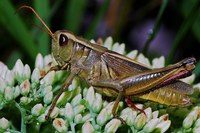Dakota Gardener: Beware of grasshoppers
(Click an image below to view a high-resolution image that can be downloaded)
By Tom Kalb, horticulturist
NDSU Extension
Grasshoppers were devastating in Dakota gardens last year. They devoured many plants from top to bottom.
Now the pests are coming back again. What caused this?
The weather during the past two years has been perfect for grasshoppers.
First, grasshoppers love a long, warm summer. This gives the insects plenty of time to eat, mate and lay lots of eggs. Last summer was long and warm. We had huge swarms of grasshoppers to begin with, and they feasted and laid a tremendous number of eggs. One female grasshopper can lay more than 1,000 eggs. A population explosion was waiting to happen this spring.
Second, grasshoppers want a late spring. If they get an early spring, their eggs hatch too early and die from a cold snap. We had a late spring this year and many baby grasshoppers avoided frosty, cold weather.
Third, grasshoppers enjoy a warm, dry spring. This provides the young grasshoppers with food and protects them from diseases. The month of May was one of the warmest ever. Food was abundant. Although the month was moist, rains were quickly absorbed by our parched soils.
Swarms of young grasshoppers are emerging out of brushy areas and ditches now. They don’t have wings yet, but they can hop over three feet at a time.
The pests are heading for our gardens where they will find moisture and succulent plants to feast upon.
Among vegetables, grasshoppers particularly enjoy eating lettuce, onions, carrots, beans and corn. Among flowers, grasshoppers prefer eating sunflowers, iris, daylily, canna lily and roses.
Now is the time to prepare for the invasion. You can spray the ditches and brushy areas where they are emerging. If you see hoppers near your garden, you can spray the borders. Spray a 10-foot swath to deter the pests.
Grasshoppers are a destructive foe. We need to show them no mercy. Once they enter our garden, we need to fight back.
I prefer to kill pests using organic insecticides. These chemicals are generally safer to use, cause less harm to bees and other beneficial insects, and don’t last long in the environment.
Spinosad is a great organic product, but it cannot control grasshoppers. Pyrethrin only works for a day or two. That’s not long enough.
Insecticidal soap has to be sprayed on the pest itself to kill it. Good luck spraying soap on swarms of jumping grasshoppers.
I tried spraying organic neem to protect my crops last year. It lessened the damage for a few days, but the pests came back in full force. I have since learned that neem is most effective on very young grasshoppers.
After my organic strategy failed, I got out the big guns.
Pyrethroids and carbaryl are our most effective weapons. These synthetic insecticides are popular and available at all garden centers. Pyrethroids include zeta-cypermethrin, cyfluthrin, bifenthrin, lambda-cyhalothrin and esfenvalerate. Look at the label and its list of active ingredients.
These chemicals are powerful and long lasting. They can give you 7 to 14 days of protection.
Use carefully because these synthetic insecticides are toxic to us. Follow the instructions on the label, and there will be a waiting period between spraying and harvesting.
These products are toxic to bees. You can reduce harming bees by spraying in the evening when bees are not active and targeting the leaves of flowering plants.
Humans have been battling grasshoppers for centuries. This year is no different. Grasshoppers are gathering in huge swarms. Get ready for battle.
For more information about gardening, contact your local NDSU Extension agent. Find the Extension office for your county at www.ndsu.edu/agriculture/extension/county-extension-offices.
NDSU Agriculture Communication – July 5, 2023
Source: Tom Kalb, 701-328-9722, tom.kalb@ndsu.edu
Editor: Kelli Anderson, 701-231-7881, kelli.c.anderson@ndsu.edu




